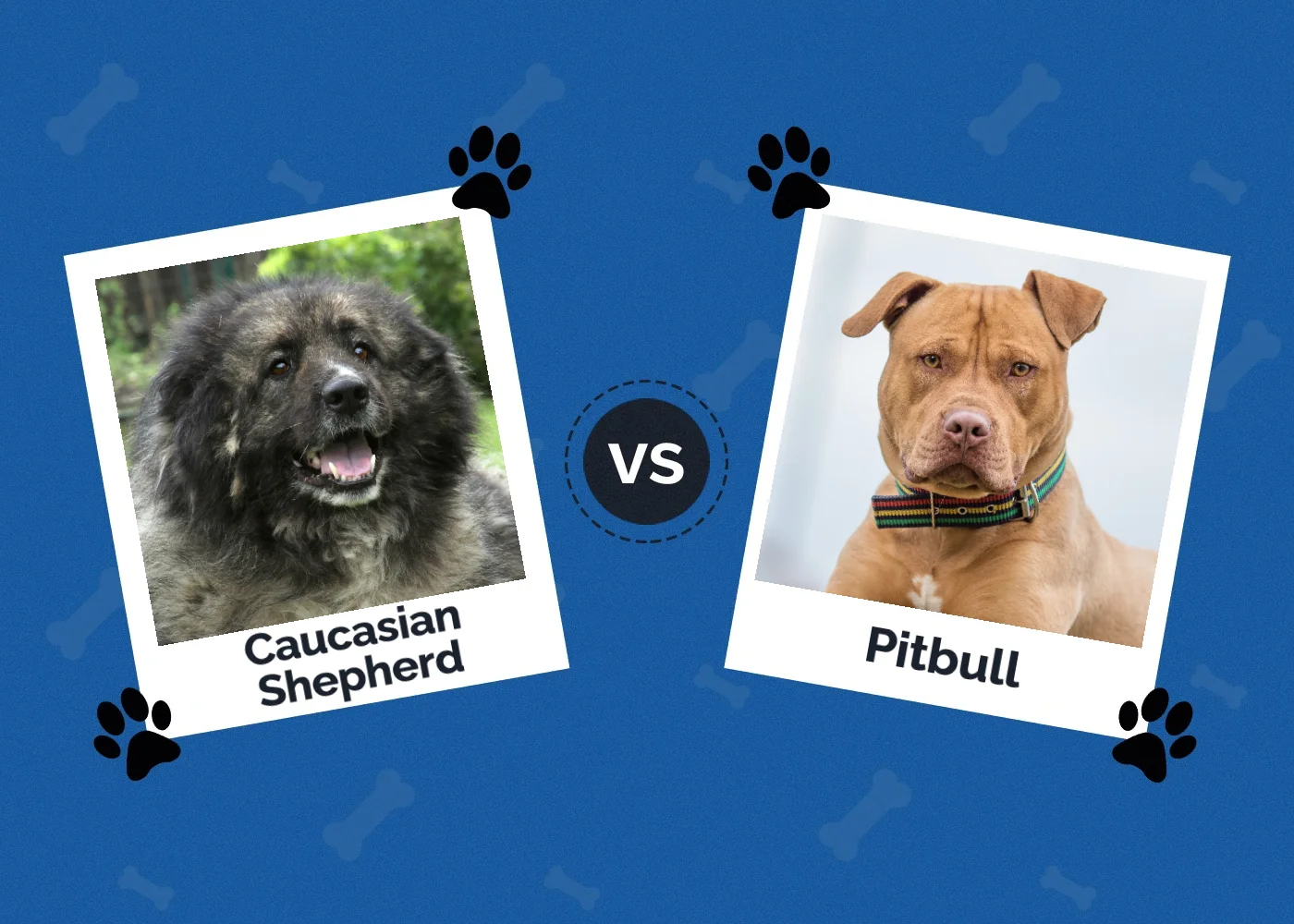Caucasian Shepherd vs. Pitbull: What’s the Difference?

Updated on

Caucasian Mountain Shepherds and Pitbulls are both large, intimidating dogs. Sadly, both also have poor reputations, though for unfair reasons! Despite their similar reputations and large statue, both of these canines are very different. They may have similar appearances and maintenance needs, but their temperaments do vary quite a bit.
These dogs are not suitable for all families. As you’ll see below, they require quite a bit of work. You need the time to dedicate to their care for them to remain happy and healthy. Assuming you have this extra free time, keep reading below to figure out which breed is best for you! So what’s the difference between Caucasian Shepherd vs Pitbull dogs?
Caucasian Shepherd vs Pitbull: Visual Differences

A Quick Overview
- Average height: 23-30 inches
- Average weight: 99-170 pounds
- Lifespan: 10-12 years
- Exercise: Moderate
- Grooming needs: Moderate
- Family-friendly: Yes, but can be territorial with strangers
- Dog-friendly: With early socialization
- Trainability: Intelligent but stubborn
- Average height: 17-19 inches
- Average weight: 40-70 pounds
- Lifespan: 12-16 years
- Exercise: Moderate
- Grooming needs: Low
- Family-friendly: Yes
- Dog-friendly: Yes
- Trainability: Eager to please
Caucasian Mountain Shepherd Overview

The Caucasian Mountain Shepherd is a guardian breed above all. They were breed for guarding purposes and still have most of those instincts today. Initially, they were used to guard livestock against smaller predators, like coyotes. They are not a breed to be taken lightly and are not suitable for all families.
These dogs are kind and devoted to their families. They can be quite affectionate, but they tend to be untrusting of strangers. It takes them a bit to warm up to people. They need a lot of early socialization and training to calm and accept family, friends, and strangers.
There are two different subtypes of Caucasian Shepherd: the Mountain type and the Steppe type. In this article, we are discussing the mountain type exclusively. This type is larger and has a long coat, while the Steppe type is smaller and has a short coat.
Temperament
As we have previously discussed, the Caucasian Mountain Shepherd is a guard dog, first and foremost. They are territorial and can be aloof with strangers. You will need to introduce them to many different people as puppies, so they learn that not everyone is an enemy. However, they are very gentle and affectionate of their family.
These dogs are quite intelligent. This is mainly because they were bred to work by themselves in the fields, guarding flocks against predators. Because they had only their wits to rely on, the smartest dogs usually did the best at guarding and were chosen for breeding. Over time, this led to a smart breed.
This intelligence comes in handy when it comes to training. These dogs need quite a bit of training to be companion dogs successfully. They can be extremely territorial and can be aggressive without proper handling. This canine isn’t particularly fond of other dogs, either. They require quite a bit of early socialization if they are to accept other canines.
Typically, they are okay with dogs they have been around most of their lives. However, they can be unaccepting of new canines unless they regularly meet new dogs.
Training
As we have already discussed, early training and socialization are beneficial for this breed. We highly recommend puppy classes, which often combine training and socialization with other dogs. These classes can help reduce some of these canines’ territorial behavior, which will make them less aggressive as adults. Puppies are far more accepting of new situations than adults, so these dogs must be introduced to people and other pets at an early age.
These dogs are quite smart, and this trait helps when it comes time for training. They can learn a variety of commands quite quickly. Besides the basic commands, these dogs are intelligent enough to participate in a variety of canine sports if you so choose.
Despite their intelligence, these dogs can be a bit stubborn. They aren’t exceptionally bred to listen to people, as they often guard flocks without a human present. Because of this, they won’t always do what you tell them to, even if they know what you’re asking. This often gets worse in their “teen” stage, which strikes at about a year of age.
Luckily, as these dog’s age, they do get less stubborn. You have to stick it out for the time being.
Typically, these dogs are decently quiet when in the house, even if they are somewhat active outside.

Health and Care
In general, these are very healthy dogs. They were bred for function above all else, so only the healthiest dogs tended to be bred. Over time, this led to a very healthy breed.
However, they are still prone to some health problems, mostly because of their size. Hip dysplasia is somewhat common. This is a genetic condition – or at least a condition that is somewhat affected by genetics. Of course, a lot affects whether or not this condition develops.
Still, if a puppy’s parents have hip dysplasia, the puppy’s odds of developing a similar problem are decently high. For this reason, you should only adopt puppies from responsible breeders that perform health checks on their canines before breeding. Dogs with hip dysplasia should not be bred to further the health of the breed.
Because these dogs have longer hair, they do have some grooming requirements. They do shed quite a bit, and a weekly brushing session can help eliminate some of this dead hair. They have relatively fast-growing nails that will need to be trimmed regularly. Ears should also be checked for debris, as this can lead to ear infections. Their teeth should also be brushed regularly.
Pitbull Overview

A “pitbull” isn’t a dog breed. Instead, it is a catch-all term that is used to describe dogs that are descended from bulldogs. Specific breeds that fall into this category include the American Pit Bull Terrier, American Staffordshire Terriers, and various mixed breeds.
To make things even more complicated, many dogs labeled as “Pitbulls” aren’t Pitbulls at all! According to one study, most dogs at shelters are mislabeled as Pitbulls when they are an entirely different breed.
This means that not all dogs that are labeled as Pitbulls are Pitbulls. It also means that pitbull traits vary quite a bit since they are actually a category of breed. Furthermore, the American Kennel Club does not recognize Pitbulls as an actual breed for apparent reasons. Without a breed standard, it can be difficult to predict what a dog will act like. The AKC does recognize the different breeds that fall under the Pitbull category.
Temperament
Despite their reputation, these dogs are not any more aggressive than your average dog. In fact, in temperament tests, Pitbulls perform similarly to Labrador Retrievers – not very aggressive at all. Only 0.24% of dogs bit without previous threatening signals. There was a connection between owners tugging on the leash to avoid stimuli and canine aggression, suggesting that owners may have more of a role in their dog’s aggression than the dog’s breed.
The pitbull is even one of the highest passing breeds on the American Temperament Test.
Instead of being aggressive like many common misconceptions suggest, these dogs are quite playful and affectionate. They can be very energetic and agile. They tend to be quite excitable, even indoors, which can get them into a bit of trouble. However, Pitbulls are also very loveable. They are incredibly affectionate and very excited about their love for you.
Most Pitbulls try to be lapdogs, even though they are often too big to fit into laps.
Training
Pitbulls are very responsive to training. They love people and are eager to please on all occasions. They aren’t the smartest, but they make up for it by their eagerness to try. Early training and socialization are required. This isn’t necessarily because these dogs are aggressive, but because of their excitability. They can be a bit to handle, so you must train them appropriately.
These dogs are very adaptable and can do well in cities if they are given enough exercise. They are often considered easy going and tend to be couch potatoes. As puppies, they can be a bit more energetic. This is where solid training starting at an early age can come in. Maturity comes pretty late for this breed, so their puppy antics can continue for some time.

Health and Care
Most Pitbulls are healthy dogs. Some health conditions are common, such as hip dysplasia and allergies. However, these are often minor when compared to other breeds and occur at a far lower rate.
A progressive disease called cerebellar ataxia is somewhat common. This involves a progressive decline in muscle coordination. Usually, it first appears between ages 3 to 5 years, which means that some dogs will have already produced puppies by the time you know they have it. It is essential to get your puppies from a breeder for this reason. Be sure the breeder tests for this genetic disorder.
As far as grooming is concerned, these dogs only need to be brushed occasionally. Pitbulls have short, stiff coats, which are very easy to take care of. A quick brush once a week will remove dirt and debris, as well as the few dead hairs that might be within the coat. Brushing also distributes the oils of their fur, which helps keep their whole coat clean.
These dogs only need a bath if they get visibly dirty. Otherwise, they stay pretty clean by themselves.
Like all dog breeds, you will need to trim their nails regularly and keep their teeth clean. Dental health is intimately connected to a dog’s overall wellbeing, so it is essential to keep their teeth clean and healthy.
Which Breed is Right for You?
If you’re looking for a guard dog, you should probably choose the Caucasian Mountain Shepherd. These dogs take a bit more maintenance due to their long coat, and they can be a bit territorial. However, they have built-in guarding instincts that make them perfect for guarding, though they require a lot of handling to be suitable companion dogs.
Simultaneously, the Pitbull is not particularly aggressive, despite some of the common misconceptions out there. These dogs are very family-friendly and are very easy to train. They tend to love everyone and show their affection very openly.
The main difference between these two dogs is that the Caucasian Shepherd lives up to its aggressive reputation more often than the Pitbull. Of course, a well-trained dog should never be aggressive, but a Caucasian Shepherd will never be friendly and upbeat with strangers.
See also:
- Labrador Retriever vs Golden Retriever: Which Breed is Best for You?
- American Eskimo Dog vs Samoyed: What’s the Difference?
Featured Image Credit: Left – Jagodka, Shutterstock | Right – Lunja, Shutterstock













